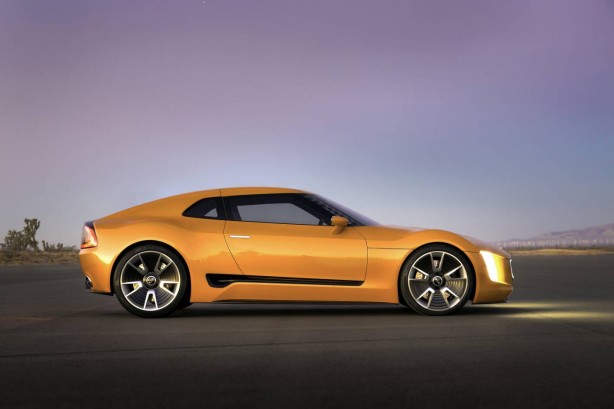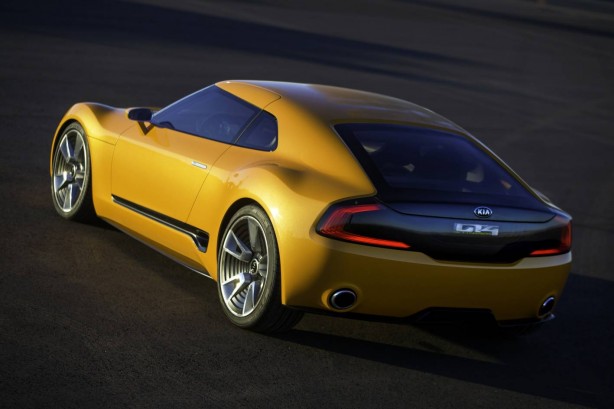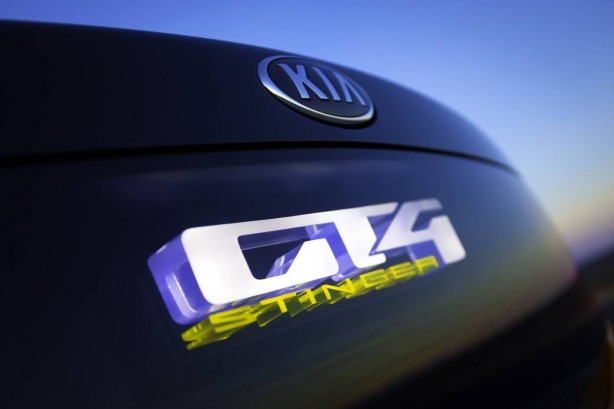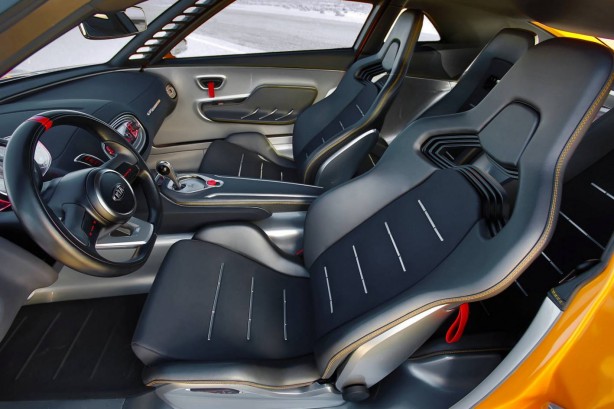Kia has unwrapped its most aggressive concept car yet at the 2014 North American International Auto Show. The eye-catching Kia GT4 Stinger is said to hark back to the days of purebred, affordable sports cars and pushes the boundaries of performance with a rear-drive 2+2 sports car that places man and machine in harmony on the road or track.
It comes as no surprise that the GT4 Stinger is the wild style child of Kia’s California design team, home to its 2012 predecessor, the Track’ster concept. And like the Track’ster, the GT4 Stinger’s racy appeal is more than skin deep.
“Driving enjoyment was the number one priority in designing the GT4 Stinger,” said Tom Kearns, chief designer, Kia Design Center America (KDCA). “It’s a 2+2 sports car that can turn heads as a daily driver while also being right at home on the track. It’s about purity, simplicity and timelessness. The GT4 Stinger is a throwback to days when driving a car was a visceral experience that wasn’t muted by electronic gimmickry.”
Emboldened by the brand’s on-track success in the Pirelli World Challenge racing series with a pair of turbocharged, GTS-class Optimas, Kia’s US design team approached the GT4 Stinger project with an eye toward weight reduction, functionality and pure driving enjoyment.
The concept shuns the luxury trappings of a traditional Grand Touring car and embraces the elemental experience of truly engaging with the vehicle.
“If anyone were to ask if Kia has the credibility to build a car like the GT4 Stinger,” noted Kearns.
“I would simply point out that Kia races – and wins – against some of the world’s most legendary performance brands.”
Beneath the low wedge of the GT4 Stinger’s bonnet resides a tuned version of Kia’s 2.0-litre turbocharged petrol direct injected (T-GDI) four-cylinder engine putting out an impressive 235kW.
“Our Optima racecars use the same engine and can produce more than 294kW, so why not infuse our concept with the kind of power that will make people take notice?” said Kearns.
That power is put to the ground via a close-ratio six-speed manual transmission driving the rear wheels, which are wrapped in 275/35R-20 Pirelli P-Zero performance tyres, while staggered 235/35R-20 Pirelli P-Zeros nestle beneath the front guards.
Custom 20-inch aluminum centre-lock wheels feature carbon fibre inserts for strength and weight reduction. Tucked inside the massive wheels are Brembo Gran Turismo two-piece 15-inch cross-drilled rotors and four-piston calipers.
Underpinning the GT4 Stinger’s sculpted “Ignition Yellow” body is a custom chassis with independent double wishbone suspension. With a shorter wheelbase (2618.7mm) and overall length (4310.4mm) than a Cerato sedan, a width (1889.8mm) greater than a Optima, and a swooping roofline nearly 225mm lower (1249.7) than a Rio subcompact, the GT4 Stinger cuts a menacing figure.
It tips the scales at a scant 1,303.6 kg, and weight distribution is spread nearly perfectly at 52 percent up front and 48 percent at the rear. The GT4 Stinger also features a quick-ratio steering rack for direct feedback and uncompromised control.
Fans of Kia’s design language, set by Kia Motors Corporation president and chief design officer Peter Schreyer, will immediately recognize key styling elements of the GT4 Stinger.
“We gave the car a shrink-wrapped appearance,” says Kearns. “It’s as if the body panels were formed around the chassis instead of merely welded to it.”
In silhouette, the GT4 Stinger is simple yet powerful. The latest iteration of the signature Kia grille rests low to the ground for maximum engine cooling and cold-air induction. The grille surround glows white and features a multi-layered, satin-black border, a theme found throughout the car.
Flanking the grille on both sides are vertical LED headlamps, and front-brake cooling vents intricately moulded into the bumper provide a clean, smooth appearance.
A carbon fibre front splitter mounted below the bumper provides added down force for the car at high speed to keep the GT4 Stinger’s front tyres firmly planted to the tarmac.
The long bonnet gently rises to meet the cowl. Two chrome accent pieces add visual interest to the otherwise ripple-less pond of Ignition Yellow sheet metal.
The bonnet closely embraces the front wheel arches, creating two protruding muscular guards above the front tyres. The result is a pronounced edge at the vehicle’s shoulders that eventually becomes the belt line.
Continuing around the car, the transparent A-pillars provide a more than 270-degree view from the driver’s seat. The layered slots cut into the pillars reduce weight while improving outward visibility.
Paying homage to the iconic Soul, the greenhouse design provides an aggressive side profile. “It’s as if the GT4 Stinger is wearing wrap-around sunglasses,” notes Kearns.
Similar to the Soul, the roof of the GT4 Stinger appears to “float” from the C-pillars. Along the rocker panels are satin black accent pieces with integrated functional cooling ducts to enhance air flow to the rear brakes.
Around back, the body widens to cover the large 275-series Pirelli rubber. The glass hatch opens to reveal a built-in storage compartment and rear strut-tower brace. The LED taillights illuminate from inside the outer edge of a blacked-out panel just above the dual exhaust ports in the rear bumper.
The interior is purposeful in design and practical in nature. The billet-aluminium door handles opens the lightweight doors with generous width for ease of entry.
There is no carpet, only a rubber floor mat underneath the billet-aluminium pedals. Front and centre to the driver is a thick D-shaped steering wheel and red LED-illuminated instrument panel with large tachometer and gear indicator.
In keeping with the track theme and taking inspiration from sports and competition cars of the past, interior door handles have been replaced by red-stitched pull straps. In fact, the GT4 Stinger makes due without the luxury of a stereo.
“The audio system starts under the hood and the speakers are the exhaust pipes,” said Kearns, referring to the car’s free-flow exhaust system.
While there are currently no plans to bring the concept to production, Kia has a history of delivering production vehicles that bear a strong resemblance to the concept that preceded them, and the GT4 Stinger provides a possible and highly provocative glimpse into Kia’s future.
When asked who the GT4 Stinger is intended for, Kearns quips, “It’s a totally selfish design. The design team at KCDA is full of gearheads and enthusiasts, and the GT4 Stinger is the perfect car for that kind of crowd.”
 ForceGT.com Car News, Car Reviews, Video Reviews, Tuning and much more.
ForceGT.com Car News, Car Reviews, Video Reviews, Tuning and much more. 










